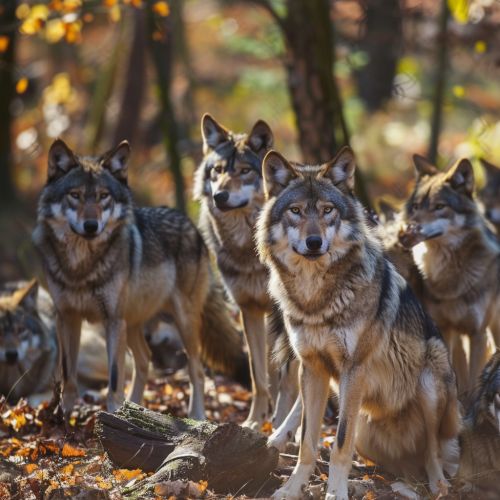Social Animal: Difference between revisions
(Created page with "== Introduction == A '''social animal''' is a species that is highly interactive with members of its own species, often forming complex social structures and engaging in cooperative behaviors. This article delves into the intricacies of social animals, exploring their behaviors, evolutionary advantages, and the various forms of social structures observed in the animal kingdom. == Characteristics of Social Animals == Social animals exhibit a range of behaviors and char...") |
No edit summary |
||
| Line 55: | Line 55: | ||
Eusociality is the highest level of social organization, characterized by cooperative brood care, overlapping generations, and division of labor. This is observed in species like ants, bees, and termites. | Eusociality is the highest level of social organization, characterized by cooperative brood care, overlapping generations, and division of labor. This is observed in species like ants, bees, and termites. | ||
[[Image:Detail-95939.jpg|thumb|center|A pack of wolves in a forest, displaying social behavior.|class=only_on_mobile]] | |||
[[Image:Detail-95940.jpg|thumb|center|A pack of wolves in a forest, displaying social behavior.|class=only_on_desktop]] | |||
== Case Studies == | == Case Studies == | ||
Latest revision as of 19:43, 3 July 2024
Introduction
A social animal is a species that is highly interactive with members of its own species, often forming complex social structures and engaging in cooperative behaviors. This article delves into the intricacies of social animals, exploring their behaviors, evolutionary advantages, and the various forms of social structures observed in the animal kingdom.
Characteristics of Social Animals
Social animals exhibit a range of behaviors and characteristics that facilitate their interactions and cooperation with others. These include communication, social bonding, division of labor, and collective decision-making.
Communication
Effective communication is crucial for social animals. They use a variety of methods to convey information, including vocalizations, body language, chemical signals, and visual displays. For instance, honeybees perform a "waggle dance" to inform hive mates about the location of food sources.
Social Bonding
Social bonding is another key characteristic of social animals. Bonds can be formed through grooming, play, and other affiliative behaviors. In primates, grooming not only helps in hygiene but also strengthens social ties and establishes hierarchies.
Division of Labor
Many social animals exhibit a division of labor, where different individuals specialize in specific roles. This is particularly evident in eusocial species like ants, bees, and termites, where there are distinct castes such as workers, soldiers, and reproductive individuals.
Collective Decision-Making
Social animals often make decisions collectively, which can enhance the survival and efficiency of the group. For example, African elephants use vocalizations and body language to reach a consensus on when and where to move.
Evolutionary Advantages
The evolution of social behavior in animals provides several advantages, including increased survival, enhanced reproductive success, and improved resource acquisition.
Increased Survival
Living in groups can enhance the survival of individuals by providing protection against predators. For instance, meerkats take turns standing guard while others forage, alerting the group to potential dangers.
Enhanced Reproductive Success
Social structures can also improve reproductive success. In many species, dominant individuals have better access to mates, while subordinates may benefit from group living by gaining indirect fitness benefits through kin selection.
Improved Resource Acquisition
Cooperative hunting and foraging can lead to more efficient resource acquisition. Wolves and lions hunt in packs, allowing them to take down larger prey than they could manage alone.
Types of Social Structures
Social animals exhibit a variety of social structures, ranging from loose aggregations to highly organized societies.
Fission-Fusion Societies
In fission-fusion societies, group composition changes frequently as individuals leave and join groups. This is seen in species like chimpanzees and dolphins, where social bonds are fluid and dynamic.
Hierarchical Societies
Hierarchical societies have a clear ranking system, often based on dominance. In baboons, for example, high-ranking individuals have priority access to resources and mating opportunities.
Eusociality
Eusociality is the highest level of social organization, characterized by cooperative brood care, overlapping generations, and division of labor. This is observed in species like ants, bees, and termites.


Case Studies
Ants
Ants are a prime example of eusocial animals. Their colonies consist of queens, workers, and soldiers, each with specialized roles. Workers forage for food, care for the young, and maintain the nest, while soldiers defend the colony.
Dolphins
Dolphins exhibit complex social behaviors, including cooperative hunting, alloparental care, and intricate communication. They form fission-fusion societies, where group composition changes frequently.
Elephants
Elephants live in matriarchal societies, led by an older female. They exhibit strong social bonds, cooperative care of young, and collective decision-making. Their social structure enhances their ability to find food and water and protect against predators.
Human Implications
Understanding social animals provides insights into human social behavior and evolution. Many principles observed in animal societies, such as cooperation, altruism, and social hierarchies, are also relevant to human societies.
